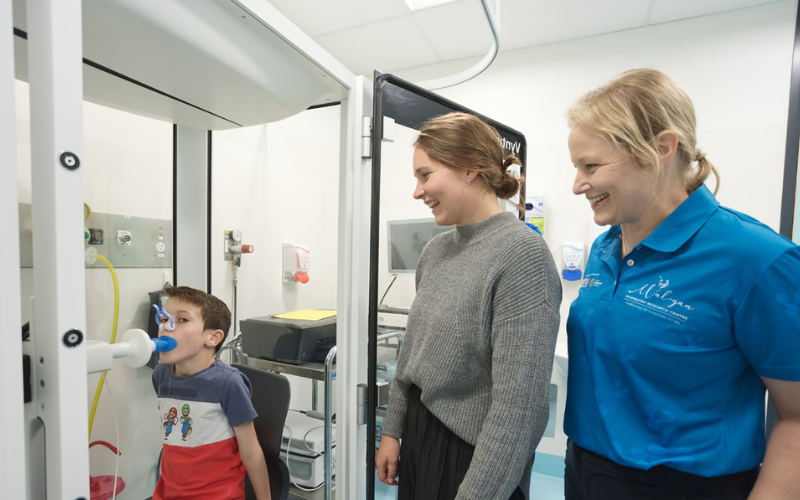
A new study has found a common asthma drug is effective for some very premature babies who go on to suffer from lung complications.
Every year nearly two million babies are born at less than 32 weeks of gestation globally. These babies face a broad range of health challenges, including respiratory problems throughout life.
Compared to babies born at full term, survivors of very preterm birth are admitted to a hospital more often and require more health care services due to their respiratory problems.
As they grow older, nearly half of these children will have breathing problems like wheeze, leading to an asthma diagnosis. However, it is thought that “preterm asthma” is different to childhood asthma, and it is unknown if asthma medications improve the lung health of this population.
In fact, this question was recognised as one of the most important questions to answer about preterm lung health by both the European Respiratory Society and the American Thoracic Society.
So far, there are no specific treatments to improve the lung health of children surviving preterm birth after discharge from the neonatal intensive care unit.
As published in The Lancet Child & Adolescent Health on 26 June 2023, a clinical trial led by Associate Professor Shannon Simpson aimed to determine the effectiveness of a common asthma medication, the inhaled corticosteroid fluticasone propionate, or ‘Flixotide’, for treating ongoing breathing problems in preterm born children aged six to 12 years old, who were born at less than 32 weeks gestation.
The five-year Preterm paediatric Inhaled CorticoSteroid Intervention (PICSI) study found that children who received the inhaled corticosteroid experienced modest improvements in lung function, compared to children in the control group, but nearly one quarter (23 per cent) of children experienced a significant improvement in their lung function.
In addition, the study identified a group of children who benefited the most from corticosteroids, based on two markers of health measured at the start of the study. This finding may one day help clinicians identify which children will benefit the most from corticosteroid treatment.
Associate Professor Simpson, who is Co-Head of the Children’s Lung Health team at the Wal-yan Respiratory Research Centre – a powerhouse partnership between The Kids Research Institute Australia, Perth Children’s Hospital Foundation and Perth Children’s Hospital – and also from the Curtin School of Allied Health, said the findings of this study may change the way some preterm babies are treated, leading to improved respiratory health in this population.
"The medical community are only just starting to understand that many survivors of very preterm birth have life-long deficits in their lung health, which may in fact be progressive over the lifespan. We urgently need effective treatments," Associate Professor Simpson said.
It's fantastic to show that inhaled corticosteroids can significantly improve lung function in a subset of children born very preterm. These results may help guide the clinical management of these children.
The study followed 87 children for 12 weeks on the inhaled medication. As a control for this study, 83 children received a placebo, which did not contain the drug.
Participants undertook a baseline visit consisting of a lung health questionnaire, lung function testing and the collection of biological samples. They were then followed up 12 weeks later to assess any changes in their lung function after taking Flixotide or a placebo twice daily for the 12-week period.
“This study is really just the tip of the iceberg in terms of what needs to be done to find effective treatments for children surviving preterm birth with prematurity-associated lung disease,” Associate Professor Simpson said.
“Further studies are now needed to work out how to predict which kids will benefit the most from this intervention, and to trial fluticasone for a longer period of time to determine if extended usage prevents lung function decline in this population.
In addition, other interventions to improve the respiratory health of kids born very preterm need to be investigated, so that we can give these kids the greatest opportunity to grow up with healthier lungs.
The paper Inhaled corticosteroids to improve lung function in children (aged 6–12 years) who were born very preterm (PICSI): a randomised, double-blind, placebo-controlled trial was published in the journal The Lancet Child & Adolescent Health and can be read here.
This research was supported by the Australian National Health and Medical Research Council and carried out in collaboration with the Curtin School of Allied Health, within the Faculty of Health Sciences at Curtin University, and the Department of Respiratory and Sleep Medicine at Perth Children’s Hospital
Pictured is seven-year-old Pierce Brazier undertaking a lung function test with Research Assistant Tiffany Bradshaw (left) and Associate Professor Shannon Simpson (right). Pierce and his twin brother Aston were born premature.
